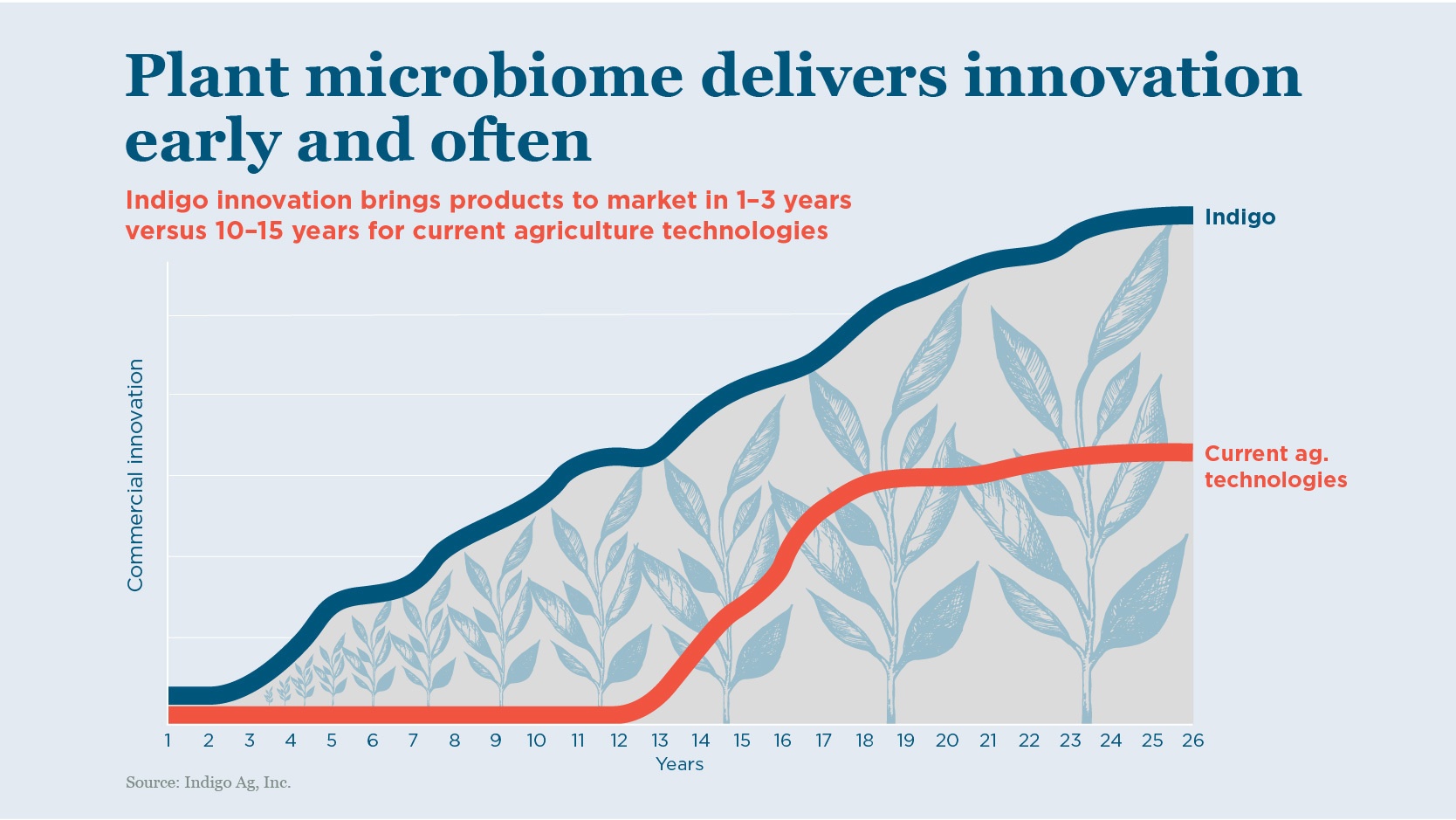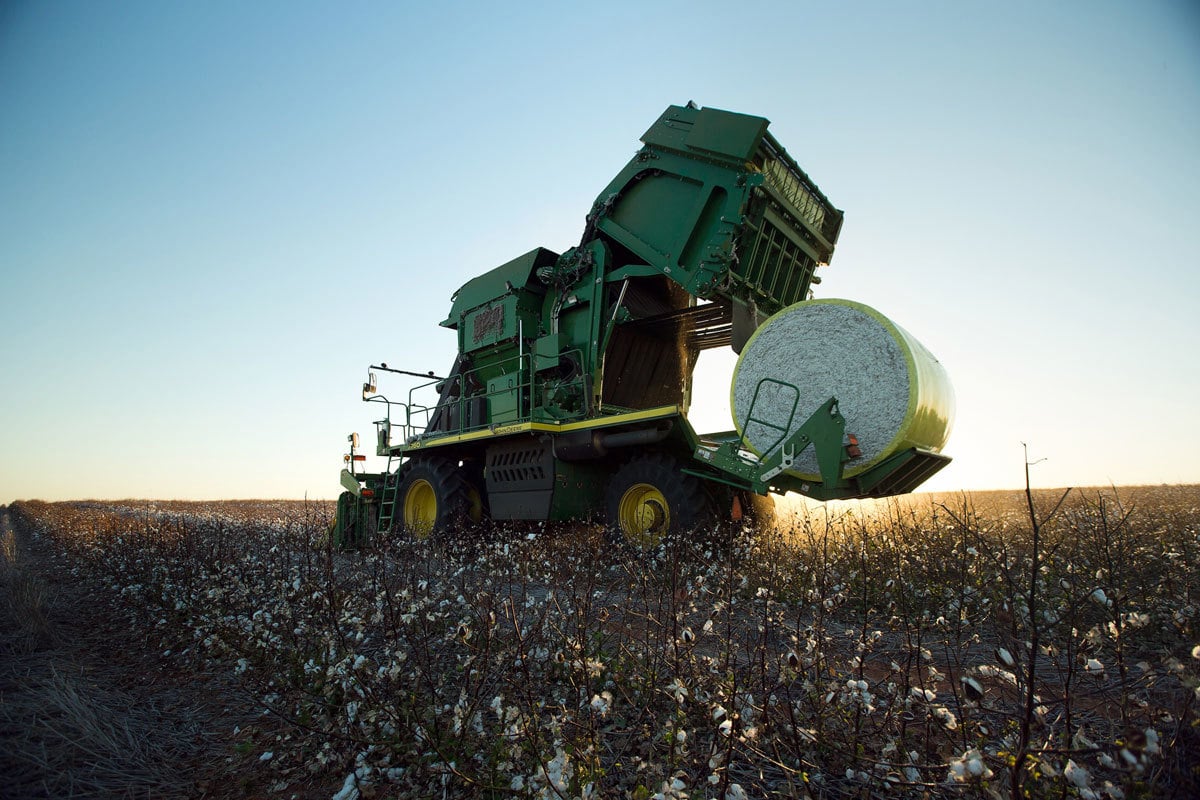Today, we are sharing the data from the commercial launch of our first product, Indigo™ Cotton.
I’m pleased to report that the commercial data indicate that Indigo Cotton led to an 11% yield increase in the target geography of West Texas, a region that produces nearly half of all US cotton. Based on our research, we had previously set the expectation of a 10% yield increase. It is inspiring to meet and exceed that expectation at large-scale, across more than 40,000 acres.
INDIGO INNOVATION: A MODEL OF CONTINUOUS IMPROVEMENT
When talking about these results, I often get the question, “Why are you still doing research on a commercial product?” The answer is, “Because we have a unique approach to Research and Development that enables continuous improvement.” I’ve outlined its five key elements below.
#1 INDIGO’S COMPUTATIONAL BIOLOGY PLATFORM
While Indigo’s products are physical (microbial products and coated seeds), the core of the company has always been our computational biology platform. We started based in part on the belief that advancements in DNA sequencing, computing power, and data analysis tools could enable for the first time a scientifically rigorous approach to identifying the microbes that nature designed to benefit plants.
This approach is the foundation of Indigo and it started with sequencing tens of thousands of microbes that live inside of plants and writing algorithms that would predict which microbes would be most beneficial in which situations. As we and our academic collaborators generate data from lab experiments, green house experiments, and field trials, we use these results to refine the algorithms. Continuing to gather commercial data from customers who are using our products under a wide range of conditions is just a natural extension of our approach to innovation.
#2 COST AND TIMING OF DEVELOPING PRODUCTS BASED ON THE PLANT MICROBIOME
Modern agriculture is built on seed breeding (seed genetics), synthetic fertilizers, crop chemicals, and genetically modified traits (GMOs). Developing new chemicals or traits takes 10 – 15 years and several hundred millions of dollars. This severely limits the speed of innovation and keeps sub-optimal products on the market for longer than necessary.
Indigo’s products, by contrast, are developed over one to three years for a substantially lower cost. That difference in cost and timing completely changes the pace at which we are able to innovate and the expected lifecycle of the product. In fact, we embrace the concept of continuous innovation and expect to update our products each year. In 2016 alone, we used several different microbes in different concentrations applied to many different seed types and planted them across diverse geographies, soil types, and climatic conditions. The results that we have collected from the commercial fields will allow us to make better choices in 2017 and hopefully to achieve even better results both with these, as well as with newly discovered microbes.

#3 THE REALIZATION OF THE LIMITATIONS OF SMALL PLOT TRIALS
Historically, new technologies in agriculture have been extensively tested in carefully controlled small plot field trials. Such controlled conditions were important because there are so many variables that affect crop yield; random variation can disguise the effect of the new technology or variety.
Over time, however, small plot trial results have begun to be viewed with a certain amount of cynicism by growers. Because the conditions are so tightly controlled, the results of small plot trials don’t always translate to grower’s fields. We began to realize the extent of the problem when we asked growers, “How much confidence do you have in company sponsored field trial results?” and the most common response was “None.”
It was when we asked growers, “What results do you believe?” and the answer was invariably “Results generated on my own farm or (maybe) on my neighbor’s farm,” that a solution began to take shape. Rather than trying to control all of the variables in small plot trials, we can simply measure them on large fields, using computational biology to sort out their effect and addressing them in the following year.
At Indigo, we think that modern technical tools are enabling a much better way to do agricultural research — a way that is credible with farmers because it is being generated by farmers.
#4 A PARTNERSHIP WITH THE GROWER
 Inherent in Indigo’s innovation model is a relationship of trust and mutual respect with growers. Growers are our foremost partners, and our ability to analyze and optimize the impact of our products on their farms relies on their feedback. Our decision to create a channel that takes products directly to growers enables us to develop close partnerships, as we collect the commercial data that will allow us to customize product offerings to grower needs.
Inherent in Indigo’s innovation model is a relationship of trust and mutual respect with growers. Growers are our foremost partners, and our ability to analyze and optimize the impact of our products on their farms relies on their feedback. Our decision to create a channel that takes products directly to growers enables us to develop close partnerships, as we collect the commercial data that will allow us to customize product offerings to grower needs.
Even then, data from commercial fields is only shared with us as a result of our business model, through which Indigo shares risk and reward with growers and is described below.
#5 SHARING RISK AND REWARD WITH OUR CUSTOMERS
The current economic model is a difficult one for farmers. They must first acquire land and equipment and then pay an increasing amount upfront for technology (seeds, traits, fertilizer, and chemicals). After planting, they take all of the risk and, if the weather cooperates and commodity prices hold up, they sell their crop for a sufficient amount to pay off their debts and have a little left over. This equation has gotten worse in the last 15 years, as increasing input prices have eroded already low average grower margins. Incredibly, after all of the recent innovation in agriculture, most farmers are no more profitable today than they were forty years ago.
At Indigo, we believe that to build a great company we must first ensure that our customers are thriving. We think that the fundamental economic model of farming needs to change so that input providers share in risk and reward with growers. We are attempting to lead in this innovation as well by pioneering new business models (such as evidence-based pricing) that allow us to forge real partnerships with growers and bring increasingly efficacious products to market.
INDIGO™ COTTON: A PROMISING STEP TOWARDS OUR GOAL OF TRANSFORMING AGRICULTURE
This product is really just the beginning. Scientists are only beginning to discover the promise that naturally occurring microbes can have for transforming agriculture. As we learn more, I expect that the benefits that we announce today will be continuously improved and that we will expand into new crops and onto the acres of growers worldwide. I also expect that Indigo’s products will reduce the tremendous amount of water currently used for agriculture and that future discoveries will allow us to reduce the use of chemical fertilizers, insecticides, and fungicides as well. Indigo’s model of continuous innovation is designed to help make those discoveries happen as soon as possible.
THANK YOU
Of course, none of this would be possible without our growers. We’d like to thank them for putting their faith in us these last few months. We at Indigo are devoted to helping them sustainably increase yields while reducing variability — improving the profitability of their farms.
I’d also like to thank our collaborators, particularly Dr. Greg Sword, from The Texas A&M University, whose early research and continued counsel have been essential to the success of our first commercial product.
And of course, I’d like to thank the Indigo team for their tireless work towards the development of our first product. Every day, I’m inspired by their unwavering commitment to our mission of helping farmers sustainably feed the planet.




